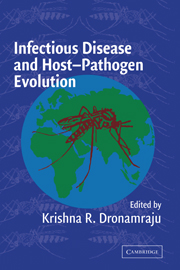Book contents
- Frontmatter
- Contents
- List of Contributors
- Introduction
- PART ONE J. B. S. HALDANE
- 1 Haldane's Ideas in Biology with Special Reference to Disease and Evolution
- 2 J. B. S. Haldane and the Malaria Hypothesis
- PART TWO MALARIAL PARASITES
- PART THREE OTHER PARASITES
- PART FOUR GENETIC AND EVOLUTIONARY CONSIDERATIONS
- Index
- Plate Section
- References
1 - Haldane's Ideas in Biology with Special Reference to Disease and Evolution
Published online by Cambridge University Press: 10 August 2009
- Frontmatter
- Contents
- List of Contributors
- Introduction
- PART ONE J. B. S. HALDANE
- 1 Haldane's Ideas in Biology with Special Reference to Disease and Evolution
- 2 J. B. S. Haldane and the Malaria Hypothesis
- PART TWO MALARIAL PARASITES
- PART THREE OTHER PARASITES
- PART FOUR GENETIC AND EVOLUTIONARY CONSIDERATIONS
- Index
- Plate Section
- References
Summary
I don't know who first had the idea that disease is a very potent agent of natural selection. I do know, however, that one of the first was J. B. S. Haldane. In The Causes of Evolution (Haldane 1932), he wrote: “A study of the causes of death in man, animals, and plants leaves no doubt that one of the principal characters possessing survival value is immunity to disease. Unfortunately, this is not a very permanent acquisition, because the agents of disease also evolve, and on the whole more rapidly than their victims.” Insightful as it was, this statement seems to have had little impact on evolutionary thought at the time (Sarkar 1992).
A further development of the subject came a few years later in a now-famous paper “Disease and evolution” (Haldane 1949b). Recognizing that density is often a limiting factor in population growth, he argued that the most important density-dependent limiting factor is a parasite. Overcrowding favors the parasite by, among other things, weakening the hosts and facilitating transmission among them. As an example, he discussed the detailed causes of death at various times in the life cycle of the gall insect, Urophora jaceana, and its various parasitoids. He noted that genetic diversity is much greater for disease resistance than, for example, resistance to predators. When a variety of wheat has been exposed to rust, a new resistant strain soon appears, followed by a new parasite strain that attacks the resistant host, and so on.
- Type
- Chapter
- Information
- Infectious Disease and Host-Pathogen Evolution , pp. 11 - 17Publisher: Cambridge University PressPrint publication year: 2004
References
- 2
- Cited by



